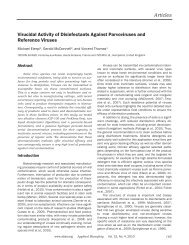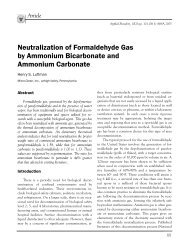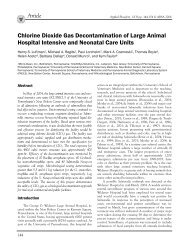Volume 10, Number 4, 2005 - American Biological Safety Association
Volume 10, Number 4, 2005 - American Biological Safety Association
Volume 10, Number 4, 2005 - American Biological Safety Association
You also want an ePaper? Increase the reach of your titles
YUMPU automatically turns print PDFs into web optimized ePapers that Google loves.
envelope or wrapping and the inner envelope or<br />
wrapping is closed with an approved security tape.<br />
• Inner envelope or wrapping must bear the security<br />
marking and the recipient’s address.<br />
• Via:<br />
a. Priority courier<br />
b. Registered mail<br />
c. A security-cleared/reliability-checked individual<br />
employed by the dispatching/receiving<br />
Facility Security Cleared Canadian organization<br />
Protected “A” and “B”<br />
• Single, gum-sealed, heavy duty envelope<br />
• Via:<br />
a. First class mail<br />
b. An individual employed with the organization<br />
c. Classified/Protected “C” methods<br />
International Transmission Standards<br />
Top Secret, Secret, Confidential, and Protected “C”<br />
• Double enveloped (gum sealed, heavy duty) and<br />
sealed with government approved security tape<br />
• Via CIISD<br />
Protected “B”<br />
• Single, gum sealed, heavy-duty envelope<br />
• Via CIISD<br />
Protected “A”<br />
• Single, gum sealed, heavy-duty envelope<br />
• Via first class mail, priority courier, or registered<br />
mail<br />
Destruction<br />
Unless otherwise specified, TOP SECRET, and<br />
PROTECTED “C” information and assets must be<br />
returned to CIISD for disposal.<br />
Unless otherwise specified, SECRET, CONFI-<br />
DENTIAL, and PROTECTED “A” and “B” information<br />
and assets of Canadian origin may be destroyed<br />
by the organization with the approval of<br />
CIISD.<br />
CLASSIFIED and PROTECTED information<br />
and assets which have been authorized for destruction<br />
must be disposed of in accordance with the<br />
following:<br />
A. Hammond<br />
• It must be destroyed only by approved destruction<br />
equipment, or at a facility authorized by CIISD.<br />
• Information awaiting destruction or in transit to<br />
destruction must be safeguarded in the manner prescribed<br />
for the most highly CLASSIFIED and PRO-<br />
TECTED information asset involved.<br />
• CLASSIFIED and PROTECTED information/assets<br />
awaiting destruction must be kept separate<br />
from other information/assets awaiting destruction.<br />
• An employee with a proper security clearance or<br />
with Reliability Status, as applicable, must be present<br />
to monitor the destruction of CLASSIFIED and<br />
PROTECTED information, respectively.<br />
• Surplus copies and waste that could reveal<br />
CLASSIFIED and PROTECTED information must<br />
be protected to the appropriate level and should be<br />
promptly destroyed.<br />
Information System Security<br />
The ISM establishes operational standards in<br />
Canadian industry for the safeguarding of Government<br />
information electronically processed, stored, or<br />
transmitted. This also applies to the safeguarding of<br />
technology assets. The administrative, organizational,<br />
physical, and personnel security standards as<br />
documented in the ISM also apply to the information<br />
technology environment.<br />
The Government Security Policy requires that<br />
the degree of safeguarding provided by industry be<br />
commensurate with the level of the information and<br />
assets and the associated threats and risks. The contracting<br />
authority is responsible for ensuring that the<br />
requirements of the Government Security Policy are<br />
met and that the security standards are applied by<br />
the private sector contractor. The security standards<br />
contained in the Government Security Policy, Information<br />
Technology Standards, are the minimum<br />
standards for security in the private sector. Assessments,<br />
advice, and guidance regarding these standards<br />
are available from the Canadian and International<br />
Industrial Services Directorate (CIISD) of<br />
Public Works and Government Services Canada<br />
(PWGSC).<br />
The prime contractor’s Information Technology<br />
Facility(s) must be approved by CIISD prior to processing<br />
government information.







